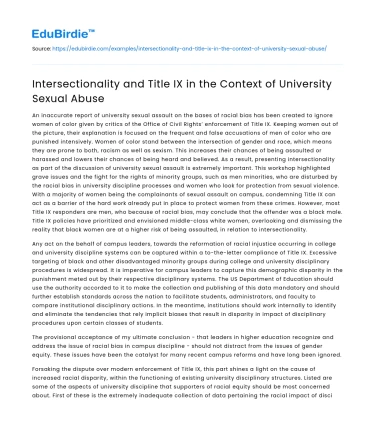An inaccurate report of university sexual assault on the bases of racial bias has been created to ignore women of color given by critics of the Office of Civil Rights’ enforcement of Title IX. Keeping women out of the picture, their explanation is focused on the frequent and false accusations of men of color who are punished intensively. Women of color stand between the intersection of gender and race, which means they are prone to both, racism as well as sexism. This increases their chances of being assaulted or harassed and lowers their chances of being heard and believed. As a result, presenting intersectionality as part of the discussion of university sexual assault is extremely important. This workshop highlighted grave issues and the fight for the rights of minority groups, such as men minorities, who are disturbed by the racial bias in university discipline processes and women who look for protection from sexual violence. With a majority of women being the complainants of sexual assault on campus, condemning Title IX can act as a barrier of the hard work already put in place to protect women from these crimes. However, most Title IX responders are men, who because of racial bias, may conclude that the offender was a black male. Title IX policies have prioritized and envisioned middle-class white women, overlooking and dismissing the reality that black women are at a higher risk of being assaulted, in relation to intersectionality.
Any act on the behalf of campus leaders, towards the reformation of racial injustice occurring in college and university discipline systems can be captured within a to-the-letter compliance of Title IX. Excessive targeting of black and other disadvantaged minority groups during college and university disciplinary procedures is widespread. It is imperative for campus leaders to capture this demographic disparity in the punishment meted out by their respective disciplinary systems. The US Department of Education should use the authority accorded to it to make the collection and publishing of this data mandatory and should further establish standards across the nation to facilitate students, administrators, and faculty to compare institutional disciplinary actions. In the meantime, institutions should work internally to identify and eliminate the tendencies that rely implicit biases that result in disparity in impact of disciplinary procedures upon certain classes of students.
Save your time!
We can take care of your essay
- Proper editing and formatting
- Free revision, title page, and bibliography
- Flexible prices and money-back guarantee
The provisional acceptance of my ultimate conclusion - that leaders in higher education recognize and address the issue of racial bias in campus discipline - should not distract from the issues of gender equity. These issues have been the catalyst for many recent campus reforms and have long been ignored.
Forsaking the dispute over modern enforcement of Title IX, this part shines a light on the cause of increased racial disparity, within the functioning of existing university disciplinary structures. Listed are some of the aspects of university discipline that supporters of racial equity should be most concerned about. First of these is the extremely inadequate collection of data pertaining the racial impact of disciplinary system and the subsequent obfuscation of procedures and collection of said data from public availability. Next is the implicit bias that colors the perspective of various parties involved - victims, investigators, witnesses and fact-finders. The vagueness of the definitions and the resulting broad scope contribute as well, as do the informal nature of the procedures and their non-uniform application. Student counsel is shackled in its efficacy due to narrow roles and is prohibitively expensive for many. Administrators and faculty, who otherwise may be forthcoming to voice support for racial justice, often show reticence to undermine the enforcement of Title IX. Last of all, deep-seated American attitudes towards interracial sex and race permeate into investigations of alleged sexual misconduct.
Did you like this example?
Make sure you submit a unique essay
Our writers will provide you with an essay sample written from scratch: any topic, any deadline, any instructions.
Cite this paper
-
APA
-
MLA
-
Harvard
-
Vancouver
Intersectionality and Title IX in the Context of University Sexual Abuse.
(2022, September 01). Edubirdie. Retrieved December 21, 2024, from https://edubirdie.com/examples/intersectionality-and-title-ix-in-the-context-of-university-sexual-abuse/
“Intersectionality and Title IX in the Context of University Sexual Abuse.” Edubirdie, 01 Sept. 2022, edubirdie.com/examples/intersectionality-and-title-ix-in-the-context-of-university-sexual-abuse/
Intersectionality and Title IX in the Context of University Sexual Abuse. [online].
Available at: <https://edubirdie.com/examples/intersectionality-and-title-ix-in-the-context-of-university-sexual-abuse/> [Accessed 21 Dec. 2024].
Intersectionality and Title IX in the Context of University Sexual Abuse [Internet]. Edubirdie.
2022 Sept 01 [cited 2024 Dec 21].
Available from: https://edubirdie.com/examples/intersectionality-and-title-ix-in-the-context-of-university-sexual-abuse/
copy






 Stuck on your essay?
Stuck on your essay?

